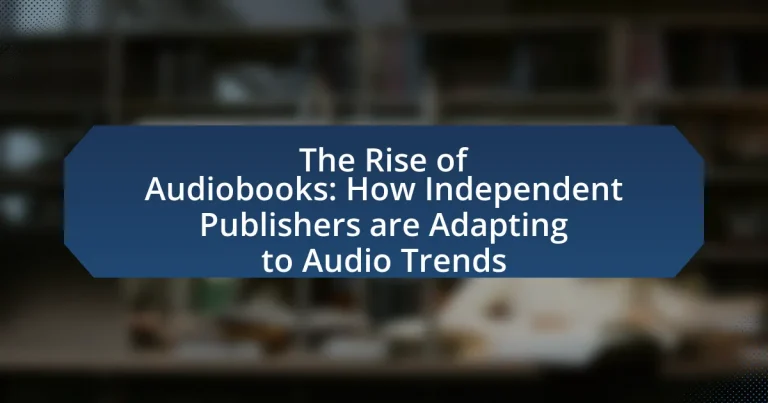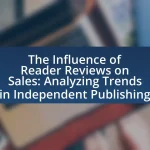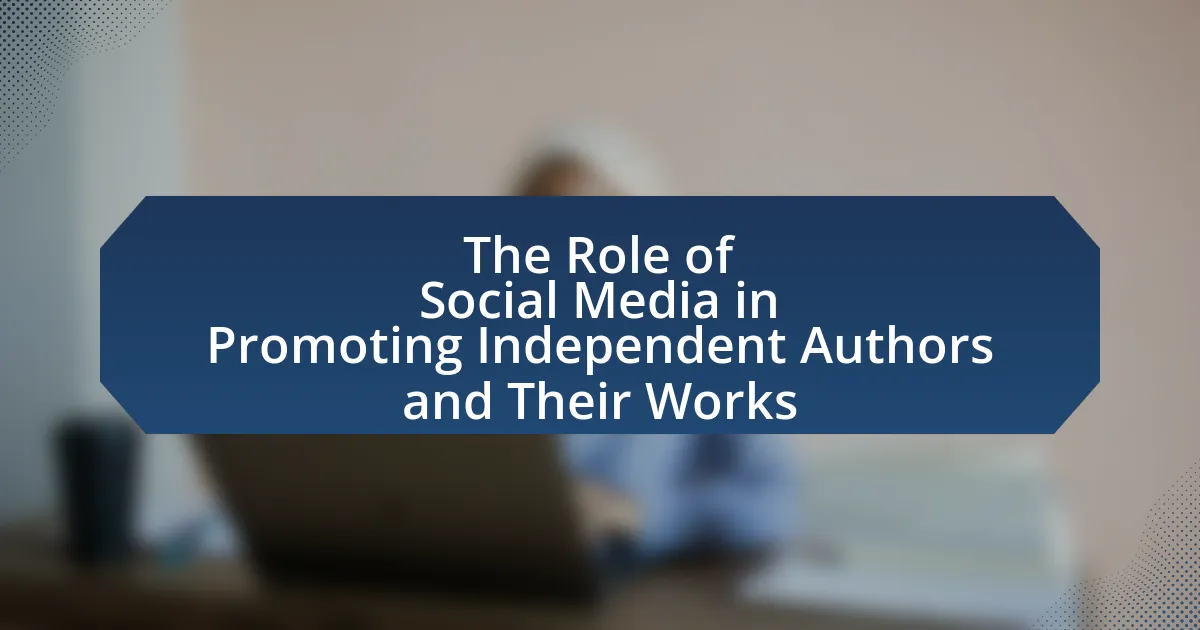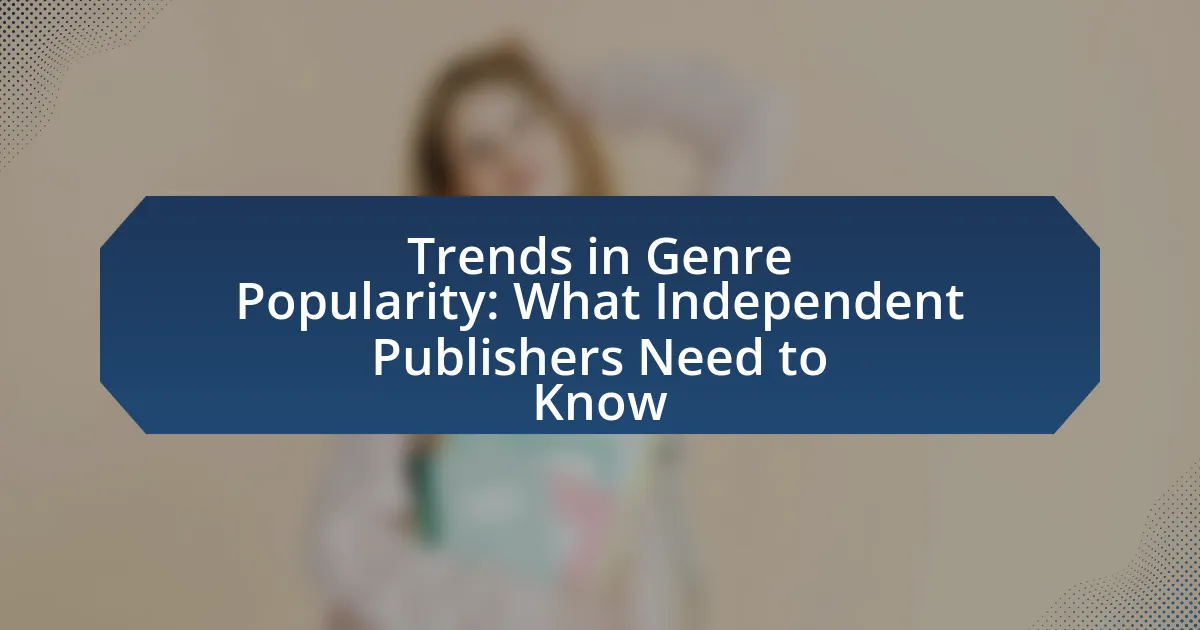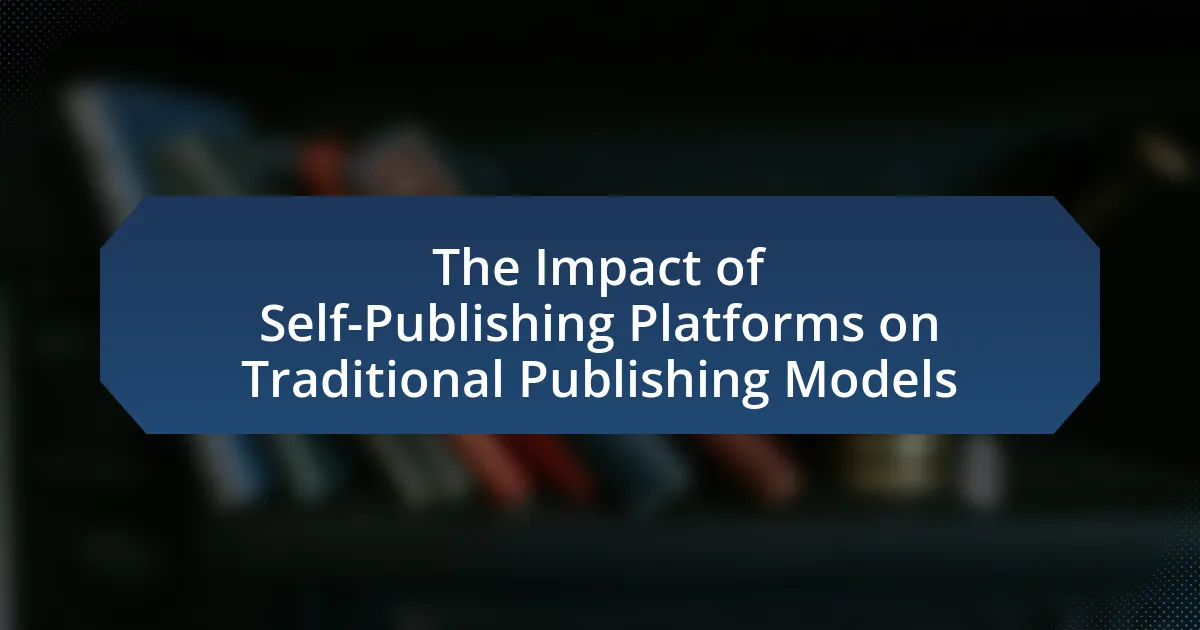The article examines the rise of audiobooks and their significant impact on the publishing industry, particularly for independent publishers. It highlights the growing consumer preference for audiobooks, driven by convenience and accessibility, as evidenced by a 25% increase in sales from 2020 to 2021. The discussion includes how audiobooks have transformed the publishing landscape, the challenges faced by independent publishers, and the strategies they are employing to adapt to audio trends. Additionally, the article explores the technological advancements influencing audiobook production and distribution, as well as the future prospects for the audiobook market.
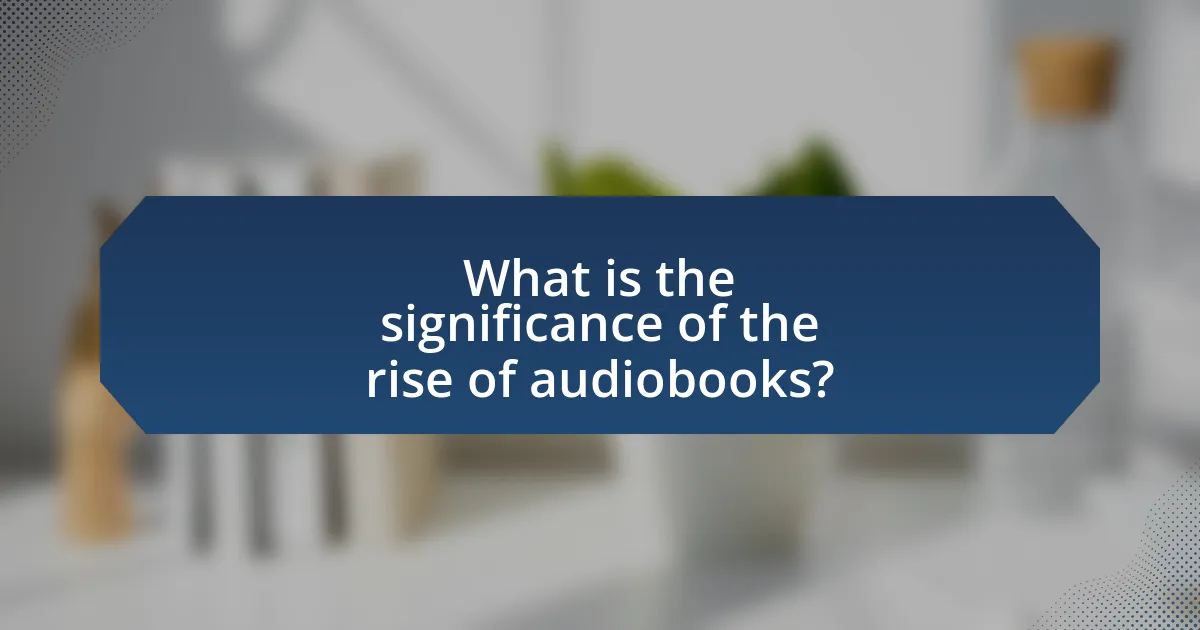
What is the significance of the rise of audiobooks?
The rise of audiobooks is significant because it represents a transformative shift in how literature is consumed, catering to the increasing demand for convenience and accessibility. This format allows users to engage with content while multitasking, as evidenced by a 2022 report from the Audio Publishers Association, which found that 70% of audiobook listeners enjoy the format while commuting or exercising. Additionally, the growth of audiobooks has expanded the market for independent publishers, enabling them to reach wider audiences and adapt to changing consumer preferences. The surge in audiobook sales, which increased by 25% in 2021, highlights the format’s growing popularity and its impact on the publishing industry.
How have audiobooks changed the publishing landscape?
Audiobooks have significantly transformed the publishing landscape by expanding the market reach and accessibility of literature. The rise of audiobooks has led to a 25% increase in audiobook sales from 2020 to 2021, according to the Audio Publishers Association, indicating a growing consumer preference for audio formats. This shift has prompted traditional and independent publishers to adapt their strategies, incorporating audio versions of their titles to cater to a diverse audience, including those who prefer multitasking or have visual impairments. Furthermore, the integration of audiobooks into digital platforms has facilitated a more direct connection between authors and readers, allowing for innovative marketing strategies and increased engagement.
What factors have contributed to the growth of audiobooks?
The growth of audiobooks has been primarily driven by advancements in technology, increased accessibility, and changing consumer preferences. Technological innovations, such as smartphones and streaming services, have made audiobooks more accessible to a wider audience, allowing users to listen on-the-go. Additionally, the rise of platforms like Audible and Google Play Books has facilitated easy access to a vast library of titles. Consumer preferences have shifted towards multitasking and convenience, with many individuals opting for audiobooks as a way to consume literature while commuting or exercising. According to the Audio Publishers Association, audiobook sales in the U.S. reached $1.3 billion in 2020, reflecting a 16% increase from the previous year, underscoring the growing popularity and market demand for this format.
How do audiobooks compare to traditional print and e-books?
Audiobooks differ from traditional print and e-books primarily in their format and consumption method. Audiobooks are audio recordings of text, allowing users to listen while multitasking, whereas print books require visual reading and e-books can be read on screens or devices. According to a 2021 report by the Audio Publishers Association, 55% of audiobook listeners prefer the format for its convenience, especially during commutes or while exercising, highlighting a significant advantage over print and e-books in terms of accessibility and flexibility. Additionally, audiobooks can enhance comprehension and retention for some users, as studies indicate that auditory learning can be more effective for certain individuals compared to visual reading.
Why are independent publishers focusing on audiobooks?
Independent publishers are focusing on audiobooks due to the growing demand for audio content among consumers. The audiobook market has seen significant growth, with sales increasing by 25% in 2020 alone, according to the Audio Publishers Association. This trend reflects a shift in consumer behavior, as more people prefer to consume literature while multitasking or commuting. Additionally, audiobooks offer independent publishers a way to reach wider audiences and diversify their revenue streams, capitalizing on the popularity of platforms like Audible and Spotify.
What challenges do independent publishers face in the audiobook market?
Independent publishers face significant challenges in the audiobook market, primarily due to limited resources and distribution networks. These publishers often lack the financial backing and marketing capabilities of larger publishing houses, making it difficult to produce high-quality audiobooks that can compete in a crowded market. Additionally, independent publishers struggle with securing distribution deals with major platforms like Audible and iTunes, which are essential for reaching a broad audience. According to a 2021 report by the Audio Publishers Association, independent publishers accounted for only 10% of the audiobook market, highlighting their struggle to gain market share against established players. Furthermore, the technical aspects of audiobook production, including narration and sound editing, can be daunting for smaller publishers without access to professional studios or experienced talent.
How do audiobooks provide new opportunities for independent publishers?
Audiobooks provide new opportunities for independent publishers by expanding their market reach and diversifying revenue streams. The growing popularity of audiobooks, which accounted for over 20% of the U.S. book market in 2022, allows independent publishers to tap into a segment of consumers who prefer audio content. This shift enables them to reach audiences who may not engage with traditional print or e-books, thus increasing their visibility and sales potential. Additionally, the relatively low production costs of audiobooks compared to print editions allow independent publishers to experiment with new titles and genres, fostering innovation and creativity in their offerings.
What trends are shaping the audiobook industry?
The audiobook industry is being shaped by several key trends, including the rise of subscription services, increased demand for diverse content, and advancements in technology. Subscription services like Audible and Scribd have transformed access to audiobooks, leading to a significant increase in listener engagement; for instance, the global audiobook market was valued at approximately $3.3 billion in 2020 and is projected to grow at a CAGR of 25.1% from 2021 to 2028. Additionally, there is a growing demand for diverse voices and stories, reflecting broader societal movements towards inclusivity, which has prompted independent publishers to adapt their offerings. Technological advancements, such as improved text-to-speech capabilities and AI narrators, are also enhancing the production and distribution of audiobooks, making them more accessible and appealing to a wider audience.
How is technology influencing audiobook production and distribution?
Technology is significantly influencing audiobook production and distribution by streamlining the recording process and expanding access to audiences. Advances in digital recording equipment and software have made it easier for authors and independent publishers to produce high-quality audiobooks at lower costs. For instance, platforms like ACX (Audiobook Creation Exchange) allow authors to connect with narrators and producers, facilitating a more efficient production process. Additionally, the rise of streaming services such as Audible and Spotify has transformed distribution, enabling instant access to a vast library of audiobooks for consumers. According to a report by the Audio Publishers Association, the audiobook market grew by 12% in 2020, highlighting the impact of technology on both production capabilities and distribution channels.
What role do consumer preferences play in audiobook trends?
Consumer preferences significantly influence audiobook trends by shaping content selection, format, and distribution methods. As listeners increasingly favor convenience and accessibility, publishers are adapting by offering diverse genres and shorter formats, such as serialized audiobooks. According to a 2022 report by the Audio Publishers Association, 55% of audiobook listeners prefer titles that are under 10 hours long, indicating a clear consumer demand for brevity. Additionally, the rise of mobile technology and streaming services has led to a preference for subscription models, with platforms like Audible and Scribd gaining popularity. This shift in consumer behavior drives independent publishers to innovate and cater to evolving listener tastes, ensuring they remain competitive in the audiobook market.
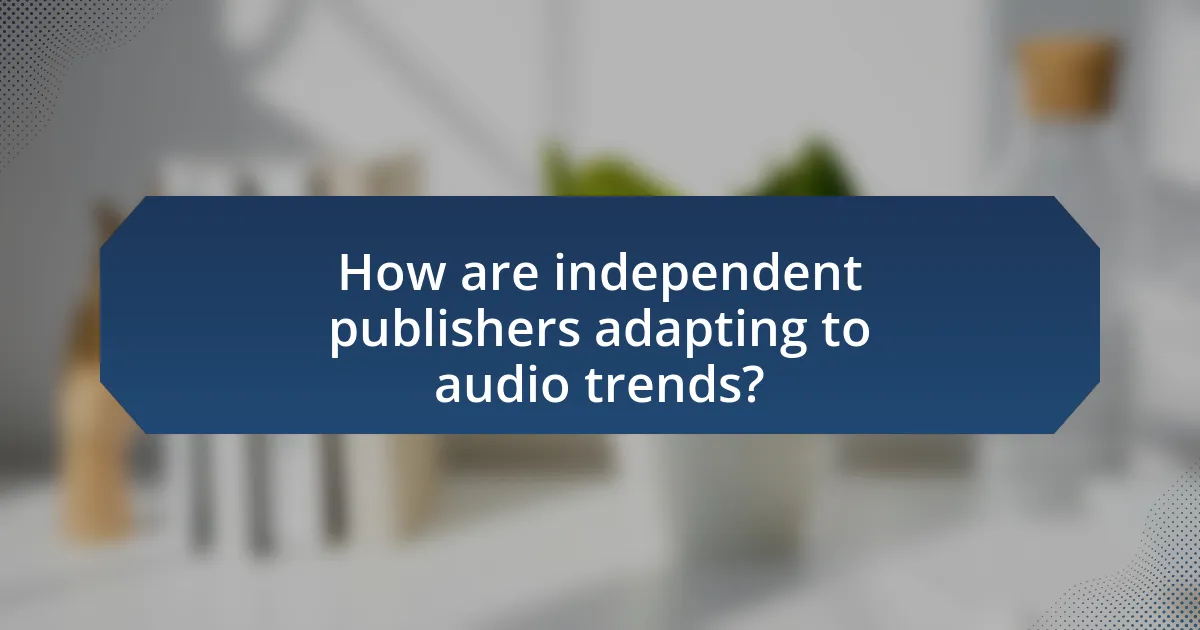
How are independent publishers adapting to audio trends?
Independent publishers are adapting to audio trends by increasingly producing audiobooks and leveraging digital platforms for distribution. This shift is driven by the growing popularity of audiobooks, which saw a 25% increase in sales in 2020, according to the Audio Publishers Association. Many independent publishers are collaborating with narrators and audio production companies to create high-quality audio versions of their titles, thus expanding their reach to a broader audience. Additionally, they are utilizing platforms like Audible and Libro.fm to distribute their audiobooks, allowing them to tap into the rising consumer demand for audio content.
What strategies are independent publishers using to enter the audiobook market?
Independent publishers are utilizing several strategies to enter the audiobook market, including leveraging digital platforms, collaborating with narrators, and focusing on niche genres. By utilizing digital platforms like Audible and Google Play, independent publishers can reach a broader audience without the overhead costs associated with traditional distribution. Collaborating with professional narrators allows them to enhance the quality of their audiobooks, making them more appealing to listeners. Additionally, focusing on niche genres enables independent publishers to cater to specific audiences, which can lead to higher engagement and sales. These strategies are supported by the growing demand for audiobooks, which saw a 25% increase in sales in 2020, indicating a robust market opportunity for independent publishers.
How are independent publishers leveraging partnerships for audiobook production?
Independent publishers are leveraging partnerships for audiobook production by collaborating with established audiobook platforms and production studios to enhance their distribution and production capabilities. These partnerships allow independent publishers to access professional narration, sound engineering, and marketing resources that they may not have in-house. For instance, collaborations with platforms like Audible or Findaway Voices enable independent publishers to reach wider audiences and benefit from the platforms’ established user bases. Additionally, partnerships with production studios can lead to higher-quality audio recordings, which are crucial for attracting listeners in a competitive market. This strategic approach not only improves the quality of the audiobooks but also increases the visibility and sales potential of independent titles.
What marketing techniques are effective for promoting audiobooks?
Effective marketing techniques for promoting audiobooks include leveraging social media platforms, utilizing email marketing campaigns, and engaging in partnerships with influencers and audiobook reviewers. Social media platforms like Instagram and TikTok allow publishers to reach a broad audience through targeted ads and engaging content, with 54% of users expressing interest in audiobooks according to a 2021 survey by the Audio Publishers Association. Email marketing campaigns can effectively reach existing customers and encourage them to explore new titles, with studies showing that personalized emails can increase engagement rates by up to 29%. Collaborating with influencers and audiobook reviewers can enhance credibility and visibility, as their endorsements can lead to increased sales and audience trust.
How are independent publishers addressing production challenges?
Independent publishers are addressing production challenges by leveraging technology and forming strategic partnerships. They utilize digital tools for efficient audio production, enabling them to streamline the recording and editing processes. For instance, many independent publishers are adopting cloud-based platforms that facilitate collaboration among authors, narrators, and sound engineers, reducing time and costs associated with traditional production methods. Additionally, partnerships with audiobook distribution services allow independent publishers to reach wider audiences without the need for extensive marketing budgets. This approach not only enhances their production capabilities but also ensures that they can compete effectively in the growing audiobook market.
What tools and resources are available for audiobook production?
For audiobook production, essential tools and resources include digital audio workstations (DAWs) like Audacity and Adobe Audition, which facilitate recording and editing. Additionally, high-quality microphones such as the Audio-Technica AT2020 and pop filters are crucial for capturing clear audio. Resources like ACX (Audiobook Creation Exchange) provide platforms for distribution and guidance on production standards. Furthermore, online courses and tutorials on platforms like Udemy and LinkedIn Learning offer valuable training for aspiring audiobook producers. These tools and resources collectively enhance the quality and accessibility of audiobook production, aligning with industry standards.
How do independent publishers ensure quality in audiobook narration?
Independent publishers ensure quality in audiobook narration by employing professional narrators, utilizing rigorous audition processes, and implementing quality control measures throughout production. They often select narrators with proven experience and skills that match the tone and style of the content, ensuring a compelling listening experience. Additionally, independent publishers may conduct multiple rounds of reviews and edits, incorporating feedback from both the production team and test audiences to refine the final product. This commitment to high standards is reflected in the growing popularity of audiobooks, with the Audio Publishers Association reporting a 12% increase in audiobook sales in 2020, indicating that quality narration is a key factor in consumer satisfaction and market growth.
What are the financial implications of producing audiobooks for independent publishers?
Producing audiobooks has significant financial implications for independent publishers, primarily involving upfront production costs, potential revenue streams, and market competition. The initial investment for audiobook production can range from $1,000 to $5,000 per title, depending on factors such as narrator fees, studio time, and post-production editing. However, once produced, audiobooks can generate additional revenue through platforms like Audible and iTunes, which have seen a 25% annual growth rate in sales, indicating a lucrative market opportunity. Furthermore, independent publishers face competition from larger publishers who may have more resources, making it essential for them to strategically price their audiobooks to attract listeners while covering production costs. This financial landscape underscores the need for independent publishers to carefully assess their budget and marketing strategies to maximize profitability in the growing audiobook sector.
How do production costs compare to potential revenue from audiobooks?
Production costs for audiobooks typically range from $200 to $3,000 per finished hour, depending on factors such as narrator fees, studio time, and post-production work. In contrast, potential revenue from audiobooks can be significantly higher, with average sales ranging from $20 to $30 per unit. For instance, if an audiobook is produced at a cost of $1,000 and sells 100 copies at $25 each, the revenue generated would be $2,500, resulting in a profit margin of $1,500. This demonstrates that while production costs can be substantial, the revenue potential often outweighs these costs, making audiobooks a lucrative market for independent publishers.
What funding options are available for independent publishers venturing into audiobooks?
Independent publishers venturing into audiobooks can explore several funding options, including grants, crowdfunding, and partnerships. Grants from organizations like the National Endowment for the Arts provide financial support specifically for audio projects, while crowdfunding platforms such as Kickstarter and Indiegogo allow publishers to raise funds directly from their audience. Additionally, partnerships with established audiobook platforms can offer financial backing or revenue-sharing models that reduce upfront costs. These funding avenues are increasingly utilized as the audiobook market continues to grow, with sales reaching over $1.3 billion in 2020, indicating a robust opportunity for independent publishers.
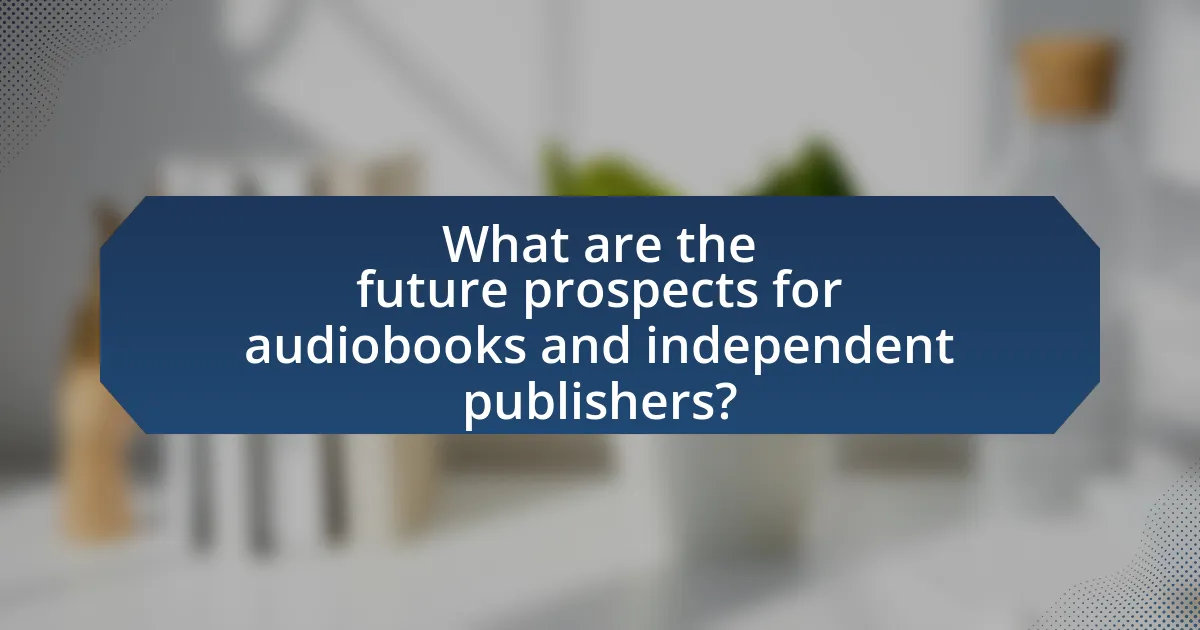
What are the future prospects for audiobooks and independent publishers?
The future prospects for audiobooks and independent publishers are highly promising, driven by increasing consumer demand and technological advancements. The audiobook market is projected to grow significantly, with a compound annual growth rate (CAGR) of over 20% from 2021 to 2028, according to a report by Grand View Research. This growth presents independent publishers with opportunities to reach wider audiences through digital platforms and innovative distribution methods. Additionally, the rise of subscription services like Audible and Scribd has made audiobooks more accessible, allowing independent publishers to monetize their content effectively. As consumers increasingly prefer audio formats for convenience and multitasking, independent publishers are likely to continue adapting their strategies to capitalize on this trend.
How might the audiobook market evolve in the coming years?
The audiobook market is likely to evolve significantly in the coming years, driven by advancements in technology and changing consumer preferences. Increased accessibility through smartphones and smart speakers will facilitate greater consumption of audiobooks, as evidenced by a 2022 report from the Audio Publishers Association indicating that 50% of Americans aged 12 and older have listened to an audiobook. Additionally, the rise of subscription services, such as Audible and Scribd, is expected to expand the market further, as these platforms offer users a vast library of titles for a fixed monthly fee. Furthermore, independent publishers are increasingly producing audiobooks to reach wider audiences, reflecting a trend where 40% of independent publishers reported an increase in audiobook production in 2021. This combination of technological integration, subscription growth, and independent publisher participation will likely shape the audiobook market’s trajectory in the near future.
What emerging technologies could impact audiobook production and consumption?
Emerging technologies that could impact audiobook production and consumption include artificial intelligence, machine learning, and advanced audio processing tools. Artificial intelligence can streamline the narration process by generating realistic voiceovers, reducing the need for human narrators and lowering production costs. Machine learning algorithms can analyze listener preferences, enabling personalized recommendations and enhancing user engagement. Advanced audio processing tools improve sound quality and accessibility features, such as real-time translation and transcription, making audiobooks more inclusive. These technologies collectively enhance the efficiency of production and the overall listening experience, as evidenced by the growing adoption of AI-driven platforms in the publishing industry.
How can independent publishers stay competitive in a growing audiobook market?
Independent publishers can stay competitive in a growing audiobook market by leveraging unique content, utilizing innovative marketing strategies, and forming strategic partnerships. By focusing on niche genres or underrepresented voices, independent publishers can differentiate their offerings from larger competitors. For instance, the audiobook market has seen a 25% growth in 2020 alone, indicating a rising demand for diverse content. Additionally, employing targeted social media campaigns and engaging with audiobook communities can enhance visibility and attract listeners. Collaborating with independent narrators and audio production studios can also improve the quality and appeal of their audiobooks, further solidifying their position in the market.
What best practices should independent publishers follow when producing audiobooks?
Independent publishers should prioritize high-quality audio production, which includes using professional narrators and ensuring clear sound quality. This practice is essential because studies show that listener engagement significantly increases with well-produced audiobooks. Additionally, independent publishers should invest in effective marketing strategies tailored to the audiobook audience, as targeted promotions can enhance visibility and sales. Furthermore, they should consider offering multiple formats, such as downloadable files and streaming options, to cater to diverse consumer preferences. By adhering to these best practices, independent publishers can successfully navigate the growing audiobook market.
How can independent publishers effectively engage with their audiobook audience?
Independent publishers can effectively engage with their audiobook audience by utilizing targeted marketing strategies and fostering community interaction. By leveraging social media platforms, publishers can create engaging content that resonates with listeners, such as behind-the-scenes insights, author interviews, and interactive Q&A sessions. Additionally, offering exclusive content or promotions, like early access to new releases or special discounts, can incentivize audience participation. Research indicates that 70% of audiobook listeners are more likely to engage with brands that provide personalized experiences, highlighting the importance of tailored communication. Furthermore, establishing partnerships with audiobook platforms and participating in relevant online communities can enhance visibility and strengthen connections with the audience.
What common pitfalls should independent publishers avoid in audiobook production?
Independent publishers should avoid several common pitfalls in audiobook production, including inadequate audio quality, poor narration choices, and lack of marketing strategy. Inadequate audio quality can lead to listener dissatisfaction; studies show that 70% of listeners abandon audiobooks due to poor sound. Poor narration choices, such as selecting narrators who do not match the tone of the content, can alienate the target audience, as 60% of listeners prefer narrators who resonate with the book’s theme. Lastly, a lack of marketing strategy can result in low visibility; according to a survey by the Audio Publishers Association, 40% of audiobook listeners discover new titles through targeted marketing efforts. By addressing these pitfalls, independent publishers can enhance their audiobook production and reach a wider audience.
